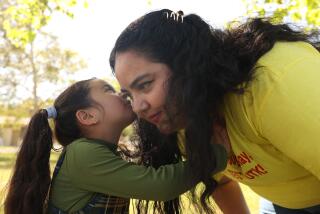READING TIPS AND NOTES / EXPERT ADVICE
- Share via
Clutching the large pencil, Codey stares at the lined paper. The 6-year-old tries to copy the marks he sees on the board with no success. He erases the paper until a gaping hole appears. “Pencil, broke!” he shouts.
Ideas fill his head, but the frustration of not being able to write them down causes him to stop trying any more.
Developmentally, we know that many young children struggle to write with the traditional tool we know as the pencil. In how many classrooms does this occur and how many students do we lose to frustration and failure in the early years of school? In how many homes does a discouraged child walk in the door and say, “I hate to read and write.”
Today, computers can empower students. Using a computer with a talking word processor, students can now show others the ideas that have been in their minds but they have been unable to express with pencil and paper.
Students, for example, type their names, then “Mom” and every word they know. The computer reads back what has been written. Children see it, hear it and read it as the computer prints it out. Children take it home to read to everyone and post on the refrigerator as proof of the ability to write.
Daily writing on the computer helps children develop their vocabulary. Words grow into sentences and stories. Since the stories come from the children’s own experiences, they make important connections. They may say to themselves, “What I can say, I can write, and what I can write, I can read and print out for others to read as well. I am a writer, a reader and an author.”
Students who begin writing on computers in kindergarten often excel in writing as sixth-graders. They create their own World Wide Web pages. They learn to communicate through e-mail with students from across the world. They use computers for their learning daily. Computers are part of their literate lives.
How can you make these things happen in your home or school?
Select software that puts the student in control of his or her own writing.
Write stories with your students. They need to see you as a writer. Print the stories and read them aloud together, noticing beginning sounds, descriptive words and other important elements of writing.
Give your students daily time to write their own ideas, listen to the computer read back the stories, print them out and read them to others.
During my many years of research, I have watched students flourish on computers. For example, I have observed first-graders at one Los Angeles school creating their own stories on the word processor. They smile proudly as they read their stories aloud. If only every one of our students could have this opportunity. Parents and teachers working together can make this happen.
To find out more on how to incorporate these ideas into your classroom or home, see Jean Casey’s book, “Early Literacy: The Empowerment of Technology,” available by calling (800) 237-6124 or by e-mail at lu-books@lu.com.
BOOK EVENTS
* Monday in Torrance: Story time for children at 7 p.m. at Bookstar, 19720 Hawthorne Blvd. (310) 793-0616.
* Thursday in Rowland Heights: Readings and performances in tribute to the book “Tacky the Penguin,” by Helen Lester at 2 p.m. at the Rowland Heights Library, 1850 S. Nogales St. (626) 912-5348.
* Saturday in Pasadena: Story time with an insect theme, including crafts at 10 a.m. Vroman’s Bookstore, 695 E. Colorado Blvd. (800) 769-BOOK.
* Next Sunday in North Hollywood: “We Tell Stories” storytelling group will perform in addition to a string trio at 2 p.m. at the North Hollywood Regional Branch, 5211 Tujunga Ave. (818) 766-7185.
More to Read
Sign up for Essential California
The most important California stories and recommendations in your inbox every morning.
You may occasionally receive promotional content from the Los Angeles Times.













